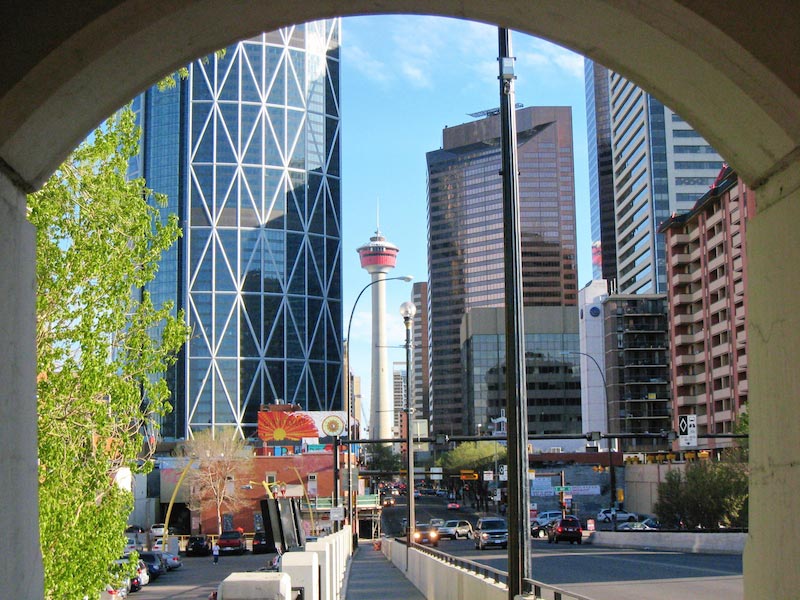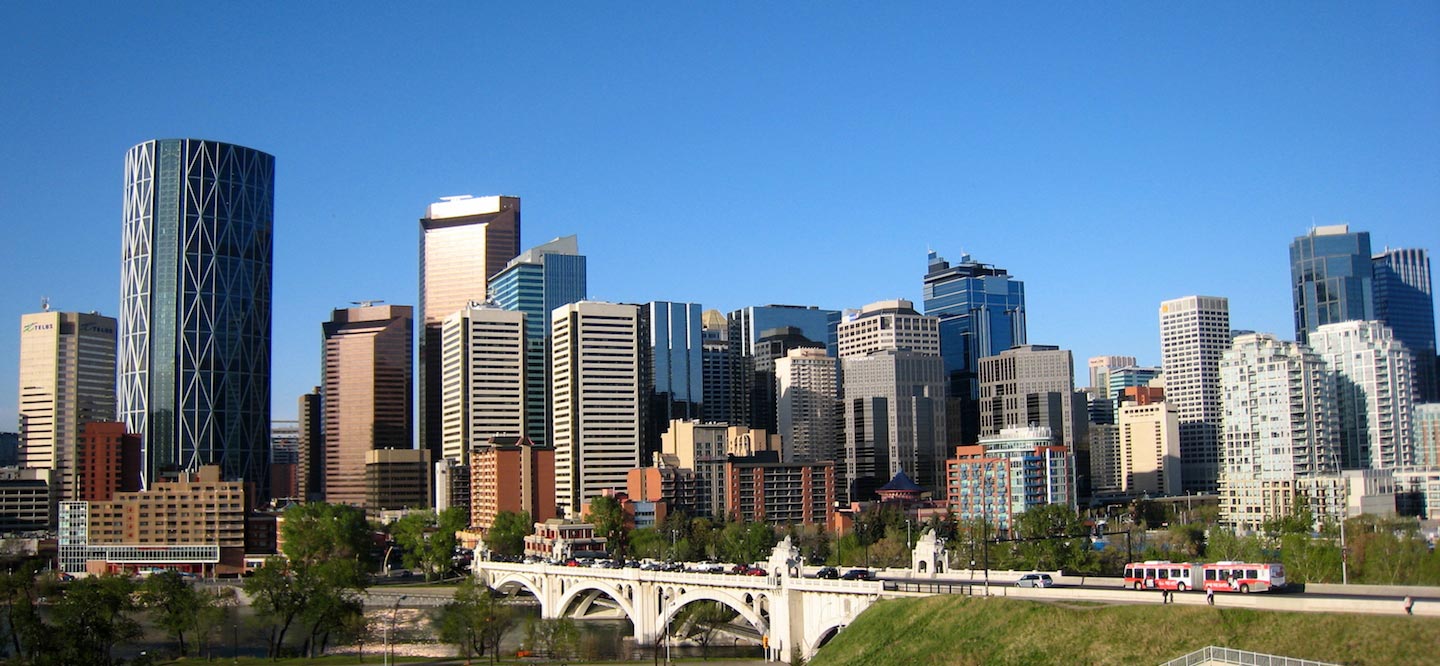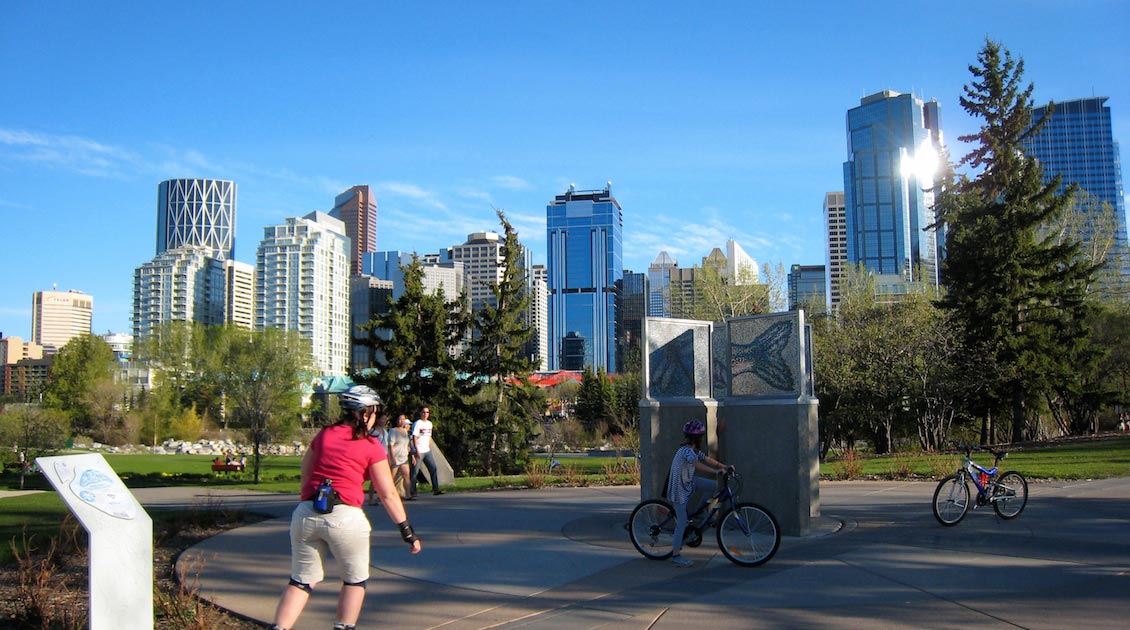Beginning as a western Canadian frontier town where the Bow and Elbow Rivers meet, Calgary has emerged as Canada’s premier oil and gas headquarters, a booming transportation centre, and the third largest city by population in the country. This rise to fame, however, has quite a colourful past.
As the bison herds dwindled across the prairies of the US and Canada from over-hunting, the valuable, high quality furs found along the eastern slopes of the Canadian Rockies became an attraction for fortune hunters. They were followed by, among others, bootleg whiskey traders, and a general lawless chaos resulted, requiring the Northwest Mounted Police to establish Fort Brisebois in 1875, renamed Fort Calgary in 1876. With law and order established, farmers and cattle ranchers soon migrated to the region to take advantage of the expansive fertile, grassy prairie.
A major turning point for early Calgary was the construction of Canada’s first transcontinental railroad. Started in 1881 and built to unite the country from the Atlantic to the Pacific oceans, the railroad was instrumental in the settlement and development of Western Canada. Calgary had the unique advantage of being in the path of this transportation corridor due to its location near Kicking Horse Pass, the nearby opening through the formidable Canadian Rocky Mountains. The railroad arrived in 1883 and thus began the city’s importance as a supply and transportation hub, sparking floods of early settlers.
 Originally named the Husky Tower, the iconic Calgary Tower was constructed by Husky Oil and Marathon Realty. It was built in 1967 and 1968 to honour Canada’s centennial. Source: Thomas SmithThe first real setback for Calgary came in 1886 when a great fire engulfed the townsite, burning the wooden structures and destroying most of the town. After the fire, the beautiful brown sandstone mined from the banks of the Bow River became the building material of choice. Calgary became renowned for its sandstone architecture, much of which is still standing today. The ‘Sandstone City’ continued to grow, reaching a population of 6,000 by 1894 when it was incorporated as a city within what was then the Northwest Territories. Ranching and agriculture were still its mainstay. Between 1896 and 1914, settlers came from all over the world with the offer of free homestead land and the cash crop economy boomed. With a 1,000% increase in population between 1901 and 1911, the city commissioned a town planner, Thomas Mawson, who presented a most ambitious plan for the city’s growth in 1914. This was never implemented because Calgary was having severe financial difficulties and the start of World War I made funding even more difficult. Consequently Calgary grew up with many of the problems Mawson predicted, such as urban sprawl and traffic congestion, but did retain some of his influence with the key placement of some government buildings and the preservation of park space.
Originally named the Husky Tower, the iconic Calgary Tower was constructed by Husky Oil and Marathon Realty. It was built in 1967 and 1968 to honour Canada’s centennial. Source: Thomas SmithThe first real setback for Calgary came in 1886 when a great fire engulfed the townsite, burning the wooden structures and destroying most of the town. After the fire, the beautiful brown sandstone mined from the banks of the Bow River became the building material of choice. Calgary became renowned for its sandstone architecture, much of which is still standing today. The ‘Sandstone City’ continued to grow, reaching a population of 6,000 by 1894 when it was incorporated as a city within what was then the Northwest Territories. Ranching and agriculture were still its mainstay. Between 1896 and 1914, settlers came from all over the world with the offer of free homestead land and the cash crop economy boomed. With a 1,000% increase in population between 1901 and 1911, the city commissioned a town planner, Thomas Mawson, who presented a most ambitious plan for the city’s growth in 1914. This was never implemented because Calgary was having severe financial difficulties and the start of World War I made funding even more difficult. Consequently Calgary grew up with many of the problems Mawson predicted, such as urban sprawl and traffic congestion, but did retain some of his influence with the key placement of some government buildings and the preservation of park space.
Energy’s Role
While fur trading, cattle ranching and the railroad played an important part in Calgary’s economy, the development of the oil and gas industry has been pivotal in forming the city’s character.
Archibald W. Dingman, born in Ontario, Canada, played a key role in Calgary’s oil history. He came west around 1902 after hearing accounts of oil and gas seeps appearing in the waters of nearby Sheep Creek. He made his way to Calgary and, along with financial partners, formed the Calgary Natural Gas Company. In 1908, Dingman drilled a productive natural gas well on the Col. James Walker Estate within the city of Calgary and laid pipe connecting it to the downtown Calgary Brewing and Malting Company to supply gas for their operations.
In 1914, just prior to the beginning of World War I, an event occurred that would drastically change the future of Calgary – Archibald Dingman and his associates struck gas in the Dingman #1 well in Turner Valley (see GEO ExPro Vol. 5, No.6), approximately 60 km south-west of Calgary. They formed the Calgary Petroleum Products Company and continued to promote Calgary as an oil and gas business centre. Oil and gas activity subsequently quieted down mainly due to the war, until 1924 when the Turner Valley Royalite #4 well hit a naptha and natural gas pocket leading to an ‘oil craze’ that changed Alberta’s economic future, with Calgary as Canada’s oil capital.
By the 1930s further exploration found crude oil deep beneath the prolific gas fields, eventually resulting in the 1947 discovery at Leduc, south of Edmonton, notifying the world that Alberta would be a major player. World War II was winding down and numerous international oil companies located their head offices in Calgary, attracted by these discoveries. Refineries were built in the city by Imperial Oil and British American Oil and the petroleum industry continued to grow.
The 1973 Arab oil embargo further stimulated the oil and gas economy while Calgary remained Canada’s administrative hub of the petroleum business. However, as with many cities so heavily based on the industry, Calgary has suffered from periodic recessions in oil prices, only to re-emerge as a vibrant international energy and financial centre.
Modern Calgary
Since the early frontier days, Calgary has evolved into a more diversified economy, although energy remains an integral part of its commercial character. With a metropolitan population of approximately 1.1 million (2011), the downtown area has continued to grow along the banks of the Bow and Elbow rivers and the city remains a hub for transportation and cargo, both by air and rail. The C-Train was one of the first light rail systems built in Canada and serves a large portion of the downtown commuters. Calgary has matured culturally as well, with a wide variety of festivals, art, and musical performances. The Glenbow Museum, located downtown, is an excellent source of Western Canada’s cultural history with an extensive art collection and an archival library. The city has its own Philharmonic Orchestra, several theatre companies, and holds the Calgary International Film Festival annually.
 Spanning the Bow River, the Louise Bridge was built in 1921. Source: Thomas SmithAlong with the skyscrapers and bustle of the downtown area, Calgary has become known for its wide array of outdoor and recreational opportunities for both winter and summer activities. With the gorgeous backdrop of the Rocky Mountains, it is surrounded by over 635 km of multi-use pathways, maintained ski trails, and bike paths. Calgary hosted the 1988 Winter Olympics, and the 400m Olympic Oval at the University of Calgary is famous for its outstanding speed skating rink. The city also features an impressive 18 km network of enclosed walkways and bridges, elevated fifteen feet above ground level (called the +15 Skywalk), allowing pedestrians to access many of the downtown buildings regardless of weather.
Spanning the Bow River, the Louise Bridge was built in 1921. Source: Thomas SmithAlong with the skyscrapers and bustle of the downtown area, Calgary has become known for its wide array of outdoor and recreational opportunities for both winter and summer activities. With the gorgeous backdrop of the Rocky Mountains, it is surrounded by over 635 km of multi-use pathways, maintained ski trails, and bike paths. Calgary hosted the 1988 Winter Olympics, and the 400m Olympic Oval at the University of Calgary is famous for its outstanding speed skating rink. The city also features an impressive 18 km network of enclosed walkways and bridges, elevated fifteen feet above ground level (called the +15 Skywalk), allowing pedestrians to access many of the downtown buildings regardless of weather.
Banff National Park, located approximately 110 km southwest of Calgary, is Canada’s oldest national park. It was established in 1885 and continues to draw visitors from all over the world to its spectacular setting in the Rocky Mountains (see GEO ExPro, Vol. 10, No. 2). The modern international airport and Calgary’s close proximity to the park and other recreational destinations has made this diverse city a jumping off point for year-round tourism.






